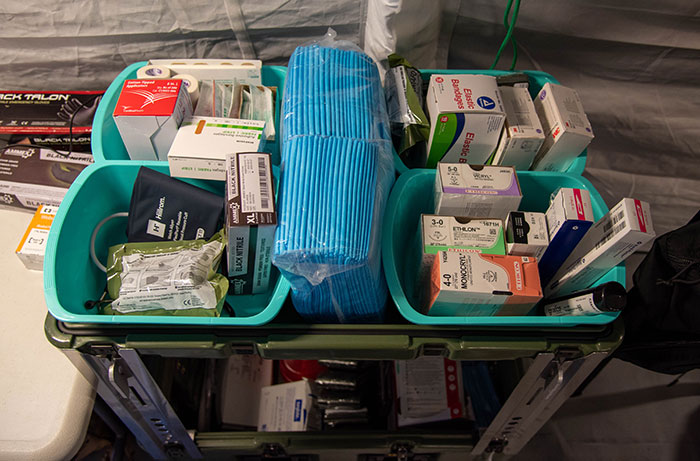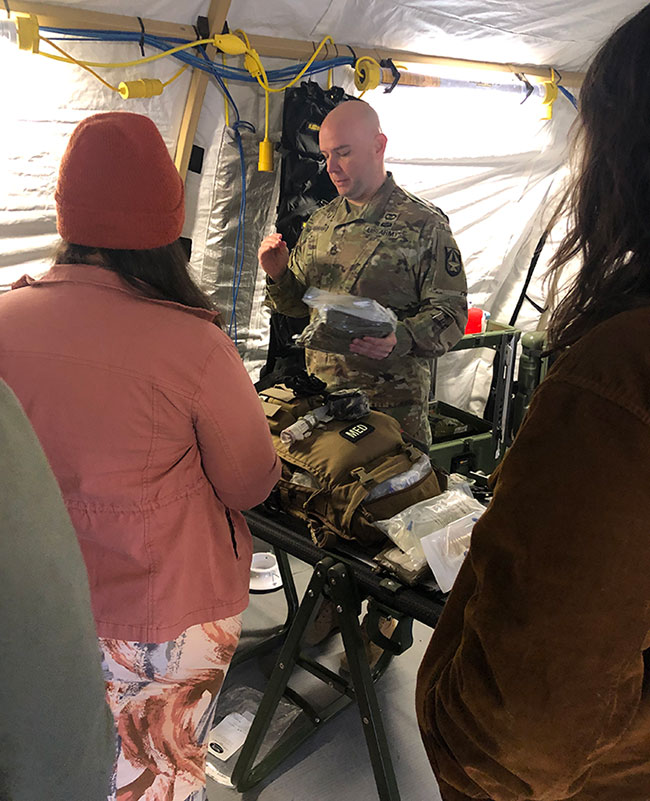Unlock, Unload: USAMMDA Events Offer Unique Medical Perspective

At an organization as sprawling as the U.S. Army Medical Research and Development Command, it's important to understand how institutional perspective can positively influence the overall acquisition process; knowing, for instance, how one decision impacts the next and so on down the line. It is for that very reason the team at the U.S. Army Medical Materiel Development Activity is holding an ongoing series of workforce awareness events at the Air Force Medical Readiness Agency grounds at Fort Detrick – to show a side of USAMRDC that few ever get to see.
"This provides an opportunity for new employees, either contractors or civilians, to put their hands on medical equipment they may not normally have the chance to," said Austin Langdon, team lead and assistant product manager for Medical Modernization with the Warfighter Deployable Medical Systems group at USAMMDA.
The kits Langdon is referring to are, cumulatively, the massive amount of medical gear and equipment delivered by the Army to a standard Role 1 care facility – including everything from the aforementioned tourniquets to bandages to litters. All told, the gear – which weighs well north of 4,200 pounds, is delivered on seven shipping pallets and stored in 17 large, waterproof plastic cases. Laid out at AFMRA, which is located on Fort Detrick grounds at Area B, the amount of supplies contained in a single TCMC kit fill nearly two full makeshift ROC 1 medical tents. It's that kind of perspective that led Langdon and others to push for this kind of "show and tell" event in the first place.
"The TCMC setup is really about giving the DOD civilian workforce an opportunity to see and interface with one of the Army's most utilized sets," said Langdon, who spent eight years as a flight medic and so knows the importance of having the right medical tools at the right time. "By having these interactive events, personnel who have not been exposed to our materiel solutions but have played a part in securing them, or maybe those who work in a different area, can have a chance to see it firsthand."

Such in-person events inevitably lead to questions from civilian and contract personnel – and, in return, insight from people with first-hand experience – which ultimately leads to a better understanding (or, as Langdon calls it, "a paradigm shift") as to why certain types of medical equipment are chosen over others, and how those choices impact the overall mission.
"I want you to see what these products feel like, how much they weigh," said Sgt. 1st Class Dan McGarrah, former Senior Enlisted Leader at USAMMDA and another Soldier closely involved in establishing the events at AFMRA. "Even when you add something of nominal weight [to the kit], it's ultimately a huge amount of weight; and so you have to consider what you're going to remove if you add something new, and you further have to consider the versatility of that new product – how many applications does it have?"
Such considerations lead to all-important perspective, and – in the end – a more informed and capable workforce, according to Langdon.
"Everything humans have made, at some point it started as an idea," he said. "I believe by educating and providing an avenue for people to explore our current set, it naturally sparks a creative atmosphere which people tend to start developing ideas and sharing them."
The next TCMC demonstration event at AFMRA is scheduled to take place in early February. If current novel coronavirus restrictions remain in place, the date will pushed back to allow for larger attendance. The goal for USAMMDA personnel is to hold such events at routine intervals for the immediate future.














